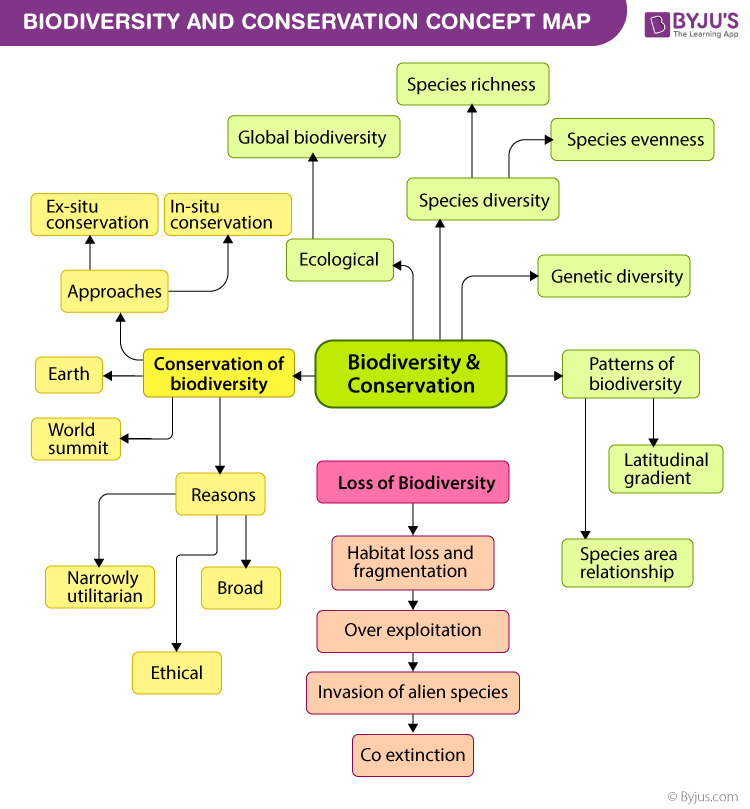Biodiversity Conservation Definition
“Biodiversity conservation refers to the protection, upliftment, and management of biodiversity in order to derive sustainable benefits for present and future generations.”
Table of Contents
What is Biodiversity Conservation?
Biodiversity conservation is the protection and management of biodiversity to obtain resources for sustainable development.
Biodiversity conservation has three main objectives:
- To preserve the diversity of species.
- Sustainable utilization of species and ecosystem.
- To maintain life-supporting systems and essential ecological processes.
Also Read: Biodiversity in Plants and Animals
Let us have a detailed look at biodiversity and its conservation notes to explore the strategies and concepts of biodiversity conservation.
Biodiversity and its Conservation Methods
Biodiversity refers to the variability of life on earth. It can be conserved in the following ways:
- In-situ Conservation
- Ex-situ Conservation
In-situ Conservation
In-situ conservation of biodiversity is the conservation of species within their natural habitat. In this method, the natural ecosystem is maintained and protected.
The in-situ conservation has several advantages. Following are the important advantages of in-situ conservation:
- It is a cost-effective and convenient method of conserving biodiversity.
- A large number of living organisms can be conserved simultaneously.
- Since the organisms are in a natural ecosystem, they can evolve better and can easily adjust to different environmental conditions.
Certain protected areas where in-situ conservation takes place include national parks, wildlife sanctuaries and biosphere reserves.
National Parks
These are small reserves maintained by the government. Its boundaries are well demarcated and human activities such as grazing, forestry, habitat and cultivation are prohibited. For eg., Kanha National Park, and Bandipur National Park.
Wildlife Sanctuaries
These are the regions where only wild animals are found. Human activities such as timber harvesting, cultivation, collection of woods and other forest products are allowed here as long as they do not interfere with the conservation project. Also, tourists visit these places for recreation.
Biosphere Reserves
Biosphere reserves are multi-purpose protected areas where the wildlife, traditional lifestyle of the inhabitants and domesticated plants and animals are protected. Tourist and research activities are permitted here.
Also Read: National Parks And Sanctuaries
Ex-situ Conservation
Ex-situ conservation of biodiversity involves the breeding and maintenance of endangered species in artificial ecosystems such as zoos, nurseries, botanical gardens, gene banks, etc. There is less competition for food, water and space among the organisms.
Ex-situ conservation has the following advantages:
- The animals are provided with a longer time and breeding activity.
- The species bred in captivity can be reintroduced in the wild.
- Genetic techniques can be used for the preservation of endangered species.
Also Read: Difference between a wildlife sanctuary and national park
Strategies for Biodiversity Conservation
Following are the important strategies for biodiversity conservation:
- All the varieties of food, timber plants, livestock, microbes and agricultural animals should be conserved.
- All the economically important organisms should be identified and conserved.
- Unique ecosystems should be preserved first.
- The resources should be utilized efficiently.
- Poaching and hunting of wild animals should be prevented.
- The reserves and protected areas should be developed carefully.
- The levels of pollutants should be reduced in the environment.
- Deforestation should be strictly prohibited.
- Environmental laws should be followed strictly.
- The useful and endangered species of plants and animals should be conserved in their nature as well as artificial habitats.
- Public awareness should be created regarding biodiversity conservation and its importance.
Why should you conserve Biodiversity?
It is believed that an area with higher species abundance has a more stable environment compared to an area with lower species abundance. We can further claim the necessity of biodiversity by considering our degree of dependency on the environment. We depend directly on various species of plants for our various needs. Similarly, we depend on various species of animals and microbes for different reasons.
Biodiversity is being lost due to the loss of habitat, over-exploitation of resources, climatic changes, pollution, invasive exotic species, diseases, hunting, etc. Since it provides us with several economic and ethical benefits and adds aesthetic value, it is very important to conserve biodiversity.

Also Read: Biodiversity
For more information on biodiversity and its conservation, keep visiting BYJU’S website or download the BYJU’S app for further reference.

Frequently Asked Questions
What do you understand by biodiversity?
Biodiversity refers to the variety of plants and animals found on earth. It measures the variations at ecosystem, species and genetic levels.
What is meant by biodiversity conservation?
Biodiversity conservation means protection, conservation and management of biodiversity in order to obtain sustainable benefits for future generations.
How can we conserve biodiversity?
Biodiversity can be conserved by:
- Preventing the cutting of trees.
- Putting a ban on hunting of animals.
- Efficient utilisation of natural resources.
- Protected areas should be developed for animals where no human activities are allowed.
Why is it important to conserve biodiversity?
Biodiversity conservation is important because biodiversity provides certain services and resources that are essential for life on earth. Biodiversity also provides social benefits.
What are the different methods of conserving biodiversity?
Biodiversity can be conserved in the following ways:
- In-situ conservation: This method helps in the conservation of biodiversity within the natural habitat of the animals and plants by creating protected areas such as national parks and wildlife sanctuaries.
- Ex-situ conservation: This method refers to the conservation of biodiversity in the areas outside their natural habitat such as zoos and botanical gardens.
Register at BYJU’S to explore biodiversity conservation notes. Refer to these notes for reference.


It is helpful to us
It’s very useful to me
Thanks to Byju’s
It is very useful and energetic for me
THANK YOU BYJU’S
It was understandable and very useful
It has been so useful for my studies.
It is very much useful for making a project.
Thank you BYJU’S
I studied biodiversity conservation. It’s very useful.
How to conserlve biodiversity